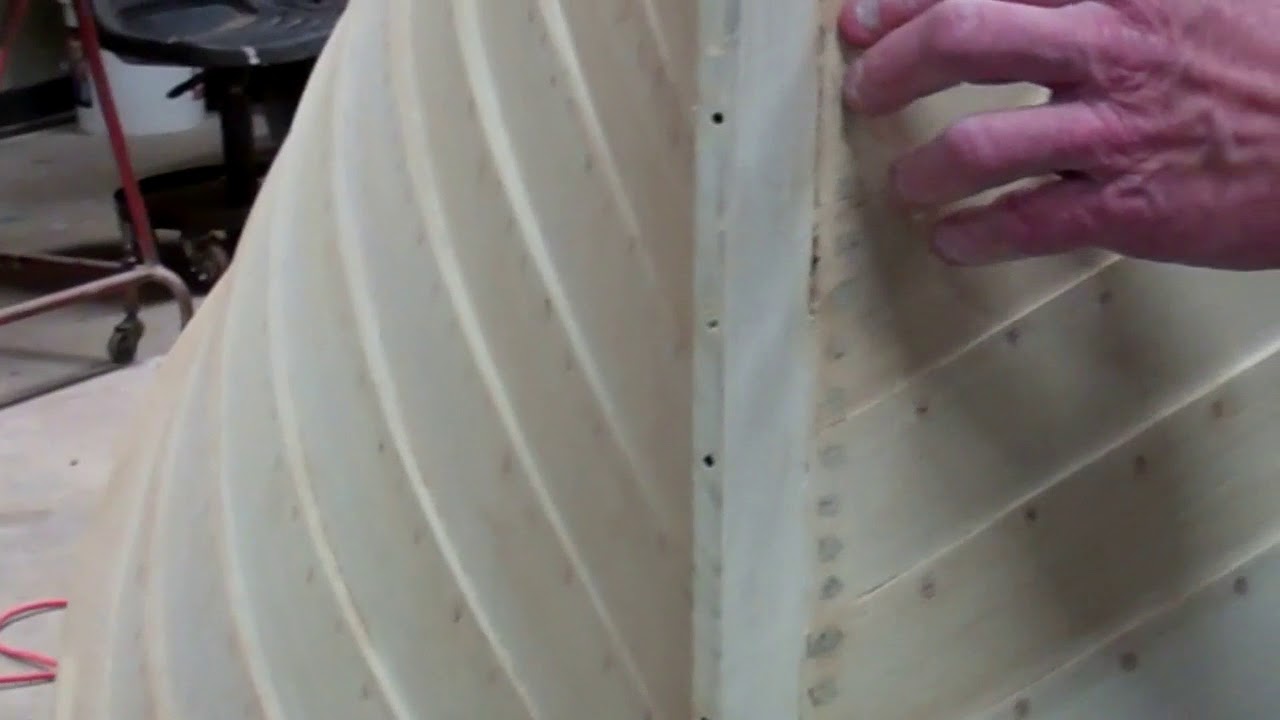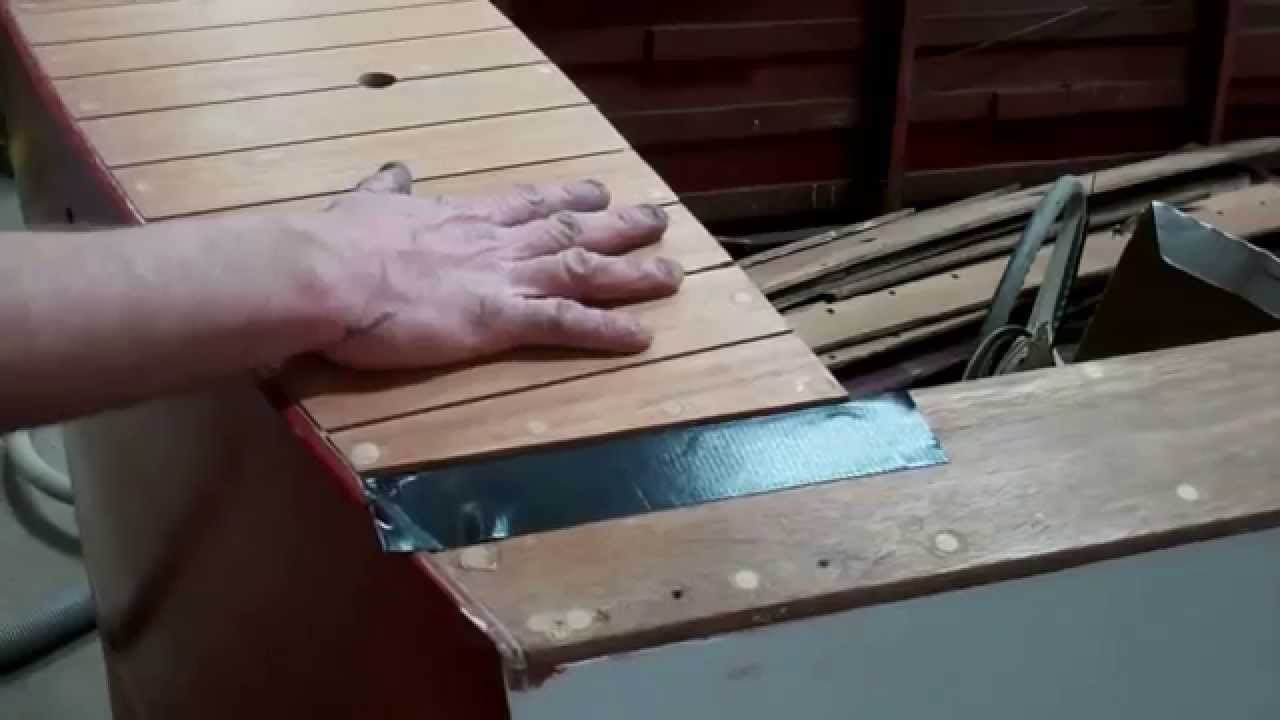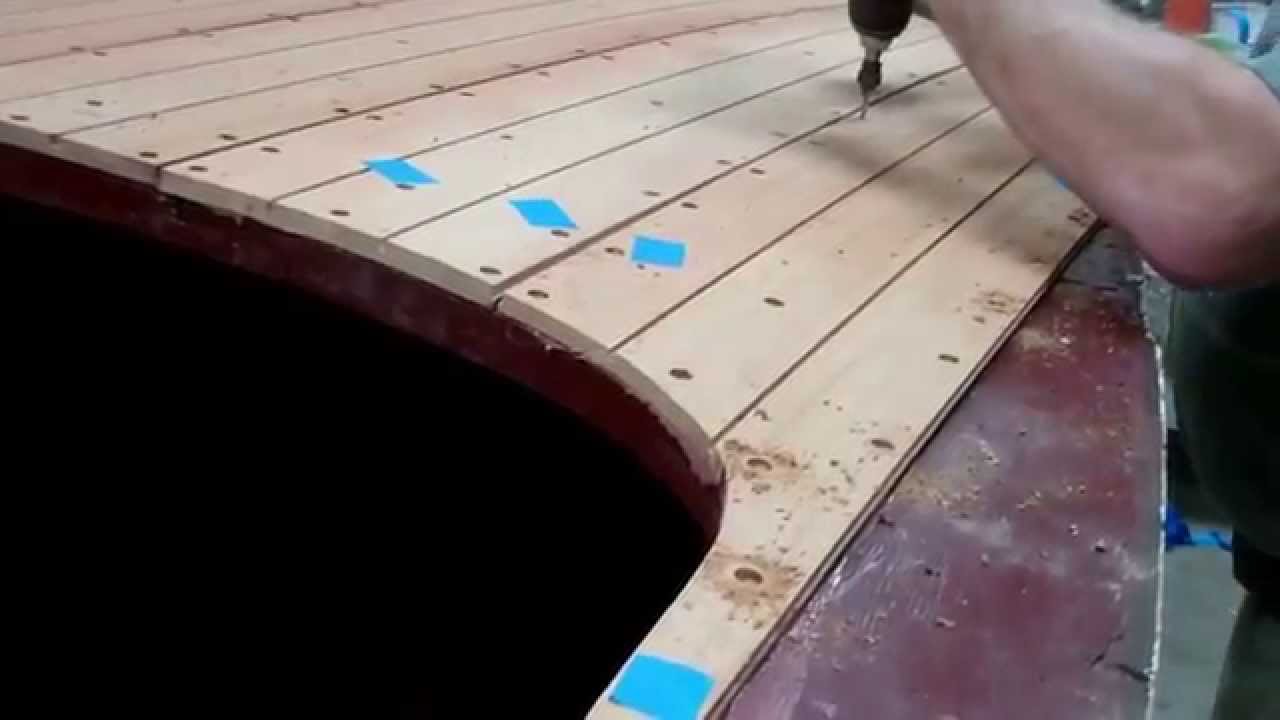With the application of her fifth coats of Interlux Perfection two-part polyurethane in Mauritius blue, Minnow is now sporting her new True 5200 bottom, save for the final coat of bilge paint that will be applied once the paint has cured and she is flipped right-side up again.
We are using this super hard epoxy paint in place of the antifouling or hard racing copper bronze alternative because Minnow will be dry sailed, and therefore not subject to bottom contamination from lake scum or critters that might otherwise adhere to it.
Having reached this major milestone, we have also reached a crossroads. If her topsides and transom are to be bleached, stained and varnished by Snake Mountain Boatworks, decision time is upon us. Once we flip her over, we simply cannot take the risk that anything, and especially wood bleach can migrate beneath tape and into the bottom paint.
We have given up on blue painter’s tape, or its much-hyped Frog Tape cousin. Duct tape leaves an awful residue. Our go-to solution for now is professional gaffer’s tape purchased from Amazon.com. It adheres tenaciously, yet leaves absolutely no reside behind when it is released.
Minnow will now sit until early next week so that her paint can cure completely.
With her Lycoming engine rebuild and a 4-hour run-in bench testing complete, Robert Henkel, Chris-Craft Parts, will be shipping it back to us at the end of next week.
Minnow will be ready to splash, probably before the hard water melts and our next boat season rushes in.
’68 Lyman Transom Dutchman Update 02 20 2015
RJ spent this week completing the small Dutchman repair to the starboard strake dry rot area, and then has turned his attention to fabricating a pretty complex transom Dutchman repair below its waterline.
He first fabricated a cardboard template which he used with ¾” marine plywood to fashion his initial blank. The latter required substantial sanding in as all of the edges are beveled as well as being curved.
His next challenge was routing out the inner surface so that the Dutchman will eventually lock into place, with the extensive shiplap joint providing substantial strength to what will be the final product.
Here, after pointing out the repairs completed on the aft ends of the bilge stringers, he demonstrates how well his Dutchman dry fits into the receiving cavity.
“All” that remains is routing out the face of the Dutchman where it will receive yet another layer of mahogany marine plywood in the area above the waterline that will be finished bright.
Truly Knock on Wood is getting some of her wood back!
1930 Dodge Runabout True 5200 Bottom Update 02 20 2015
With the application of her fifth coats of Interlux Perfection two-part polyurethane in Mauritius blue, Minnow is now sporting her new True 5200 bottom, save for the final coat of bilge paint that will be applied once the paint has cured and she is flipped right-side up again.
We are using this super hard epoxy paint in place of the antifouling or hard racing copper bronze alternative because Minnow will be dry sailed, and therefore not subject to bottom contamination from lake scum or critters that might otherwise adhere to it.
Having reached this major milestone, we have also reached a crossroads. If her topsides and transom are to be bleached, stained and varnished by Snake Mountain Boatworks, decision time is upon us. Once we flip her over, we simply cannot take the risk that anything, and especially wood bleach can migrate beneath tape and into the bottom paint.
We have given up on blue painter’s tape, or its much-hyped Frog Tape cousin. Duct tape leaves an awful residue. Our go-to solution for now is professional gaffer’s tape purchased from Amazon.com. It adheres tenaciously, yet leaves absolutely no reside behind when it is released.
Minnow will now sit until early next week so that her paint can cure completely.
With her Lycoming engine rebuild and a 4-hour run-in bench testing complete, Robert Henkel, Chris-Craft Parts, will be shipping it back to us at the end of next week.
Minnow will be ready to splash, probably before the hard water melts and our next boat season rushes in.
1930 Dodge Runabout True 5200 Bottom Update 02 20 2015
With the application of her fifth coats of Interlux Perfection two-part polyurethane in Mauritius blue, Minnow is now sporting her new True 5200 bottom, save for the final coat of bilge paint that will be applied once the paint has cured and she is flipped right-side up again.
We are using this super hard epoxy paint in place of the antifouling or hard racing copper bronze alternative because Minnow will be dry sailed, and therefore not subject to bottom contamination from lake scum or critters that might otherwise adhere to it.
Having reached this major milestone, we have also reached a crossroads. If her topsides and transom are to be bleached, stained and varnished by Snake Mountain Boatworks, decision time is upon us. Once we flip her over, we simply cannot take the risk that anything, and especially wood bleach can migrate beneath tape and into the bottom paint.
We have given up on blue painter’s tape, or its much-hyped Frog Tape cousin. Duct tape leaves an awful residue. Our go-to solution for now is professional gaffer’s tape purchased from Amazon.com. It adheres tenaciously, yet leaves absolutely no reside behind when it is released.
Minnow will now sit until early next week so that her paint can cure completely.
With her Lycoming engine rebuild and a 4-hour run-in bench testing complete, Robert Henkel, Chris-Craft Parts, will be shipping it back to us at the end of next week.
Minnow will be ready to splash, probably before the hard water melts and our next boat season rushes in.
1940 Lyman 16′ Yacht Tender – How to Paint Bottom & Bleach Topsides
John texted me early this morning, “That little Lyman turned into an albino!” Yes she did.
He experimented with our customary bleaching process. Rather than just applying and leaving the Daly’s Wood Bleach be, during the 5-1/2 hours bleach was being applied, he periodically scrubbed the surface ever so lightly with Scotch Brite pads.
One data point proves nothing, but given the absolutely uniform results, John, RJ and I will be treating the transom of the 1957 23’ Lyman Runabout to the same process.
Yes, I know that choosing Pettit Hard Racing Copper Bronze for the bottom paint is an anathema to the Lyman world, but my decision was driven by the reality that she will be a trailer- and lift-sailed boat, for which antifouling paint is not well suited.
John has worked his usual invisible Dutchman magic, and the countersink filler he concocted using two-part TotalBoat Thixo 2:1 Epoxy, cypress sand dust and Sandusky natural filler stain 9805, is a nearly exact match. (We decided against using wood bungs as the countersinks along the stem and aft transom corners are way too shallow for glue to hold them in place.
Now it is time for the wood to dry down to about 12-15 percent, at which time we will stain the topsides and transom with Sandusky natural filler stain 9805, and then seal everything with three coats of CPES.
Soon she will be albino no more!
1946 Gar Wood Ensign New Deck Milestone Reached Almost
Friday the 13th turns out to be a near milestone day for the 1946 Gar Wood Ensign deck planking project.
As it opens, you can enjoy with John and me seeing all the planking, fasteners and bungs in place, and all of the deck seams having been routed out.
What remains? As we explained in earlier reports, both decks were flying loose and sagging where they met the gunwales. That droop hid the fact that the deck boards we removed were actually thicker than are the covering boards. As a result, the new planking is proud of the covering boards now that the framework has been completed.
We use the Veritas Detail Flush-Cutting Saw, with a 26 TPI blade (05K34.10) for trimming the bungs fair with the surface. It is the first flush-cutting saw we’ve used that absolutely will not scratch the surface around the bung.
John’s final challenge, one that begins with 40 grit paper on our longboard sander, and ends with 80 grit, is to sand the decks fair with the covering boards.
Bleaching will follow as will follow, which we will chronicle for the community.
46 Gar Wood Ensign’s New Deck Milestone Reached Almost 2 13 2015
Friday the 13th turns out to be a near milestone day for the 1946 Gar Wood Ensign deck planking project.
As it opens, you can enjoy with John and me seeing all the planking, fasteners and bungs in place, and all of the deck seams having been routed out.
What remains? As we explained in earlier reports, both decks were flying loose and sagging where they met the gunwales. That droop hid the fact that the deck boards we removed were actually thicker than are the covering boards. As a result, the new planking is proud of the covering boards now that the framework has been completed.
John’s final challenge, one that begins with 40 grit paper on our longboard sander, and ends with 80 grit, is to sand the decks fair with the covering boards.
Bleaching will follow as will follow, which we will chronicle for the community.
68 Lyman 20′ Runabout Waterline Dry Rot Dutchman Repair 2 13 2015
In stripping off the boot stripe, to which muddy red antifouling paint had been applied, RJ unearthed about 15” of dry rot at the starboard waterline, just outside of where the helm station seat back attaches to the topside framing. The area around the rot is in excellent shape, so we are adopting a Dutchman strategy for addressing the issue.
As you see in the clip, RJ has routed about 3/8” into the strake’s face, save for the area in the middle of the cut where the rot passes all the way through. He will create a Dutchman having a raised area that will fit into the void, while the balance of the patch will mate to the remaining strake material. Placing a block inboard of the repair will afford us a solid mounting surface when we insert the Dutchman bedded in Thixo Thickened epoxy.
We will keep you up to date as these issues are addressed.
RJ has also finished scraping loose paint from the bottom edges of the topside planks, and discovered some separation that we could not close with using hammer and shoe to tighten the clinch nails. (They are uniformly very tight along the strake overlaps.)
So we have applied white 3M5200 to the entire topside strake overlap seams.
1946 Gar Wood Ensign Deck Planking Update
We are nearing a major milestone on the 1946 Gar Wood Ensign deck replanking portion of this preservation project.
Fabricating two small sections of planking, fastening them bedded in 3M5200, bunging the countersinks and sawing the excess away, and we will be ready for sanding and fairing the decks and covering boards.
Bleaching and staining will be next, followed by rolling, tipping and sanding coats of varnish.
We will be using Epifanes Gloss Clear Varnish on the decks and transom at the request of the owner.
Lyman Runabout Transom Deconstruction at Finish Line
RJ has almost completed the deconstruction phase of preserving this 1968, 20’ Lyman Runabout’s transom.
As you see in this clip, while most of the repairs are below the waterline, we face the challenge of fabricating a fairly large Dutchman above it where the transom is finished bright. We have some mahogany plywood that has very similar grain, and will hide the vertical joint at the right end of the Dutchman behind the port exhaust flange.
RJ must first clean out the rot and fill what was a terrible water trap with Thixo Thickened Epoxy and repair the aft ends of the bilge stringers that had wicked up water and have rotted in a ways as a result.
We have sealed all of the new framing with three coats of CPES and are applying Sandusky Lyman sand tan bilge paint to them as I type. Once the new frame members are in place, we can begin fabricating, sealing and installing the two Dutchmen that will complete the transom repair.



